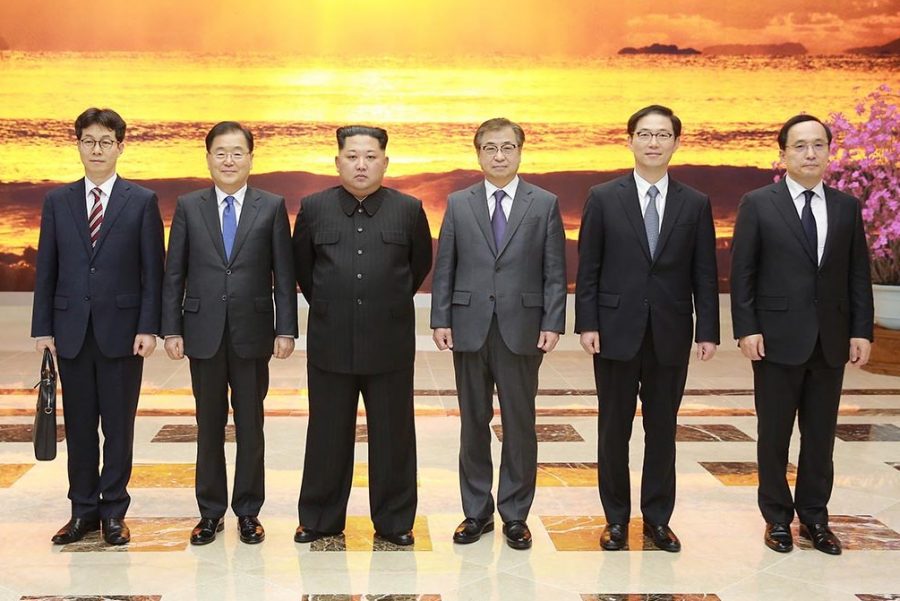A Close Encounter But With No Avail
World leaders Donald Trump and Kim Jong Un fall short of agreeing to meet at a Summit to discuss the future of the two nations.
May 29, 2018
For the first time since the Korean War in the early 1950’s, a U.S. President will once again meet face-to-face with the current leader of North Korea.
On May 10, President Donald Trump announced his meeting with Supreme Leader Kim Jong Un of North Korea at the North Korea Summit Meeting.
A summit meeting, or simply known as a summit, is an international meeting held between the heads of governments in order to discuss global governance. The most notable summit includes one that was held between Franklin D. Roosevelt, Winston Churchill and Joseph Stalin during World War II.
Plans to coordinate the North Korean-United States summit began on March 8, 2018 with the geography and neutrality of the location the initial chief concern of the meeting.
The DMZ, or the demilitarized zone, between North and South Korea, as well as the city-state of Singapore and the country of Mongolia were among the top choices to be considered for the summit.
The Southeast Asian city-state has been the preferred location among US officials who saw its neutrality as an advantage over locations closer to Pyongyang, such as the DMZ and Mongolia.
Ultimately, the decision came down to Trump who revealed the location and time of the historic summit meeting on Twitter.
“The highly anticipated meeting between Kim Jong Un and myself will take place in Singapore on June 12th,” Trump tweeted on May 10. “We will both try to make it a very special moment for World Peace!”
Trump’s optimism for the future of the North Korean – United States relationship improved with the release of three captive Americans – Tony Kim, Kim Hak-song, Kim Dong-chul – from the North Korean border.
“We are starting off on a new footing — I really think we have a very good chance of doing something very meaningful. A lot of very good things have happened,” said Trump as he greeted the former prisoners at Joint Base Andrews.
The release of the three prisoners, all American citizens of Korean descent, was a diplomatic victory as it showed Kim’s attempts to to improve relations with the United States after several decades of mutual antagonism.
The peace was soon disrupted as more disputes between the two nuclear-armed nations arose.
North Korea threw President Trump’s planned summit meeting with its leader, Kim Jong-un, into doubt, threatening to call off the landmark encounter if the United States insisted on “unilateral nuclear abandonment.”
According to South Korea, Kim has said he’d be willing to give up his nuclear weapons if the United States commits to a formal end of the Korean War and pledges not to attack the Northern counterpart.
But North Korean Diplomat Kim Kye-kwan stated otherwise, rejecting the administration’s demand that it quickly dismantle the country’s nuclear armament program.
“If the United States is trying to drive us into a corner to force our unilateral nuclear abandonment, we will no longer be interested in such dialogue and cannot but reconsider our proceeding to the D.P.R.K.-U.S. summit,” stated Kim Kye-kwan in a North Korean diplomatic statement.
Trump followed and rejected Kim’s offer to withdraw American troops from the Korean Peninsula, stating that withdrawing U.S. forces from South Korea is “not on the table.” Approximately 28,500 U.S. forces are based in the allied nation, a military presence that has been maintained to deter North Korea since the war ended in 1953 without a peace treaty.
A prospective peace treaty between the Koreas, however, could diminish the need of U.S. forces in South Korea.
A previous Korean Summit Meeting on April 27 at the Peace House located in the DMZ between the two conflicting countries between South Korean President Moon Jae-In and North Korean Chairman Kim Jong Un was held in attempt to establish peace throughout the Korean Peninsula.
In the April meeting, Kim told South Korean emissaries that he hoped the United States and South Korea would adjust their annual military drills when the situation stabilizes.
On May 15, North Korea cut off talks with its southern counterpart and threatened to cancel the planned U.S.–North Korea summit, citing the Max Thunder military protocols practiced between the United States and South Korea.
Max Protocol is an annual exercise to maintain military readiness to defend South Korea.
State Department spokeswoman, Heather Nauert, commented: “Kim Jong-un had said previously that he understands the need and the utility of the United States and the Republic of Korea continuing in its joint exercises. They are exercises that are legal. They’re planned well, well in advance.”
“The defensive nature of these combined exercises has been clear for many decades and has not changed,” said Defense Department spokesman Col. Rob Manning.
As of May 24, the historic meeting between the two leaders was cancelled weeks before the set date of June 12.
President Trump, citing several threats stated by the North Korean regime, pulled out of the highly anticipated meeting, commenting that “this missed opportunity is a truly sad moment in history.”
However, Trump states that the summit could still happen.
“Based on the tremendous anger and open hostility displayed in your most recent statement, I believe it is inappropriate, at this time, to have this long-planned meeting,” Trump wrote in an official statement. “Please let this letter serve to represent that the Singapore summit, for the good of both parties, but to the detriment of the world, will not take place.”
Photo Credit: Blue House (Republic of Korea)








